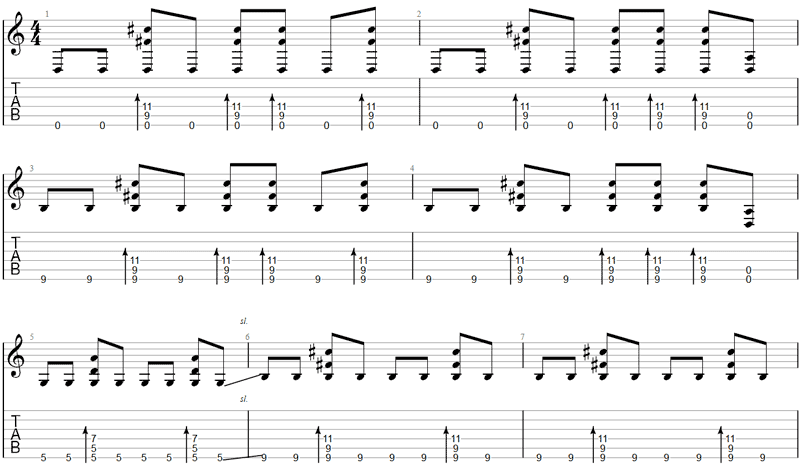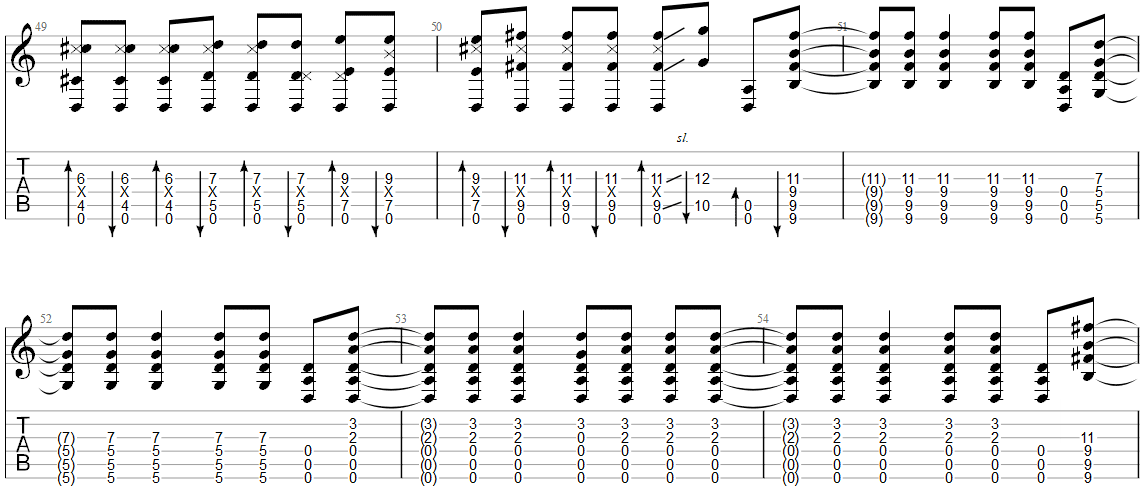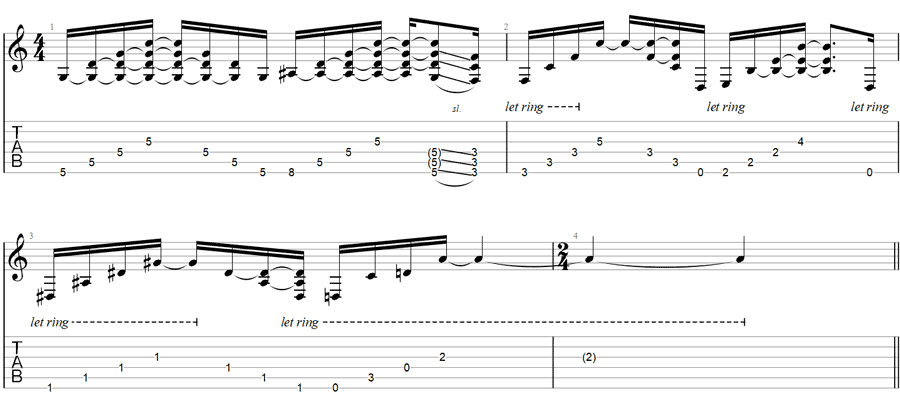Drop D is a fun tuning to use on guitar and there are countless songs that use it.
In this lesson, let’s go through some of the easiest guitar songs in Drop D. I’ll explain how to play the main riffs in the song along with tips and advice to get you started.
If you want to learn more about Drop D Tuning, check out my Ultimate Guide to Drop D here.
If you want to learn how to write your own riffs and songs in Drop D, check out this Drop D lesson.
Everlong by Foo Fighters
Everlong is a great example of how Drop D can work for an electric guitar as well as acoustic guitar.
The acoustic version of this song is as popular as the full-band version and you play it almost the same way on guitar. So whether you’re learning acoustic or electric guitar, this is a great song to get you started with Drop D tuning.
Main Riff
In the below Guitar TAB of the main riff, you can see that the song uses a lot of sus2 chord shapes, which are playable in standard tuning, but very easy in Drop D tuning.

The arrows on the Guitar TAB are to let you know that you’re playing down-strokes on the chords. In fact, the best way to play this song is to play everything using downstrokes.
Learn about the symbols used in Guitar TAB here if you’re unsure of anything.
To make this riff really pop, add palm muting to every single note (in other words, everything except the chord hits).
Once you memorize the chord progression, focus your effort on your timing. Everything in this part uses eighth notes, which means there is a constant one-and-two-and-three-and-four-and rhythm.
Use a metronome to tighten up your rhythm. Start with a slow tempo and gradually increase the tempo when you can play without any mistakes.
Chorus
In the leadup to the chorus, you’ll be using octave shapes and gradually sliding up the fretboard.

The ‘x’ in between the two octave notes lets you know that you don’t want to hear that string ring out. To do this, you press your index finger down on the note on the A string, then lightly curl it so it touches the D string.
This is a very commonly used shape, so it’s great practice. When you string that first chord, you should only hear three note: the open string, the 4th fret on the A string, and the 6th fret on the G string. You shouldn’t hear the D string ring out if you have properly muted it.
Practice this part slowly at first and make sure you slide your hand up to the right positions. As you feel comfortable with the octave shape, you can gradually increase the tempo.
You can either use all downstrokes or alternate strumming (down up down up) in this section. Watch Dave Grohl play this live if you want to see how he plays it and the way he moves his fretting hand up.
The above section is played twice before the chorus chords kick in:

Notice that it starts off with the same octave shapes as earlier. The only difference is that this time it shifts to a higher chord starting on the 9th fret.
These are incredibly simple chord shapes and shows why Drop D is such a popular tuning.
Listen carefully to the song to get the feeling of the strumming pattern. Tap your hand along with the rhythm to get the feel for it, then when it feels natural you can try it on the guitar.
Check out the full Guitar TAB for this song on Ultimate-guitar.com
Tips for learning this song:
- Spend plenty of time working on your rhythm with a metronome
- Watch a live version to see how Dave Grohl strums each part
- Don’t speed up unless you can play the part slowly without any mistakes
- Make sure you properly mute the strings for the octave part
Once you can play the two parts shown above, you’ll have no problem learning the rest of the song.
Slither by Velvet Revolver
The main riff to Slither is a great example of how you’re able to jump around with power chords in Drop D.
A lot of riffs in Drop D follow this style of playing due to the fact that you can play a power chord with one finger.

Trying to play this riff in standard tuning would be awkward and would never sound as clean as it does in Drop D tuning.
The first thing to do when you want to learn a Drop D riff like this one is to memorize the fret positions you’ll be playing in order.
If you just look at the bottom string notes (the low D string), you can see the notes are: 0 3 4 0 6 7 0 10 0 6 7 0 5 0 3 4.
That might seem like a lot of notes to memorize, but it’s a quick and easy job when you use a few simple tricks.
First, break the notes into small groups to memorize. Sometimes this will be groups of three notes, sometimes four or five notes, but most riffs can be broken down into a group of notes.
Here’s how I would group the notes together: (0 3 4) (0 6 7) (0 10) (0 6 7) (0 5) (0 3 4).
If you listen to the song, it will make sense why I have grouped the notes together like this.
Once you memorize the order of notes, all you need to do is figure out which fingers to use to play each power chord.
There are many ways to do this, but for this example, I suggest using your first finger (index finger) on the lowest fret in each group, then your second finger (middle finger) for the next highest fret.
So the first three power chords (0 3 4) would be played open (0), first finger (3), second finger (4).
This might seem confusing at first, but with enough practice, you’ll find that you start learning efficient finger placements for any new song you start learning.
If you like coming up with power chord riffs, try tuning in Drop D and see how it changes your approach to riff writing. Check out this lesson to learn how to write riffs in Drop D.
Black Hole Sun by Soundgarden
Chris Cornell used a lot of different tunings (check out this guide to alternate tunings to learn more), so if you’re interested in alternate tunings, there are plenty of examples in Soundgarden’s songs.
Black Hole Sun is in Drop D tuning and is an interesting song to learn. It features some great guitar tones and effects you don’t usually hear.
If you try to play along with this song, you might notice that it doesn’t sound quite right. That’s because the guitars in this song are tuned halfway between D and Eb. So while you can play this song in Drop D, the actual recording is slightly sharp.
In other words, don’t worry if it doesn’t sound quite right if you try and play along with the song. Even if you play it perfectly, it will sound slightly out-of-tune.

The great thing about Drop D Tuning is being able to play simple chord shapes like the above riff.
Think about which fingers make the most sense to play these arpeggios (an arpeggio is a chord played one note at a time).
This Drop D riff is also great practice for learning barre chords. Being able to flatten your first finger (index finger) across the strings is an important skill to learn.
Make sure that each note rings out and you don’t hear buzzing or muted notes. It might take a bit of finger pressure at first, but over time your finger will toughen up and you’ll find you don’t need to press down very hard.
Schism by Tool
If you want plenty of examples of Drop D in action, Tool uses Drop D as their main tuning.
What makes Schism an interesting Drop D song is that most of the riffs don’t use the low D string at all. So when a riff like the one below finally does make use of that low D string, it packs a lot of power.

Simple power chord-based riffs like the above feel completely different than similar riffs in standard tuning.
The ‘x’ represents muted hits, which means you lightly rest your fretting hand over the string to create a muted sound when you strum the strings. Muted hits are a great way to get a more aggressive sound compared to palm muting.
The last four notes in the riff should flow smoothly. It shouldn’t sound like three notes, then another note. It should sound like four notes in a row without any gap as you change strings.
This can be tricky for beginners, but the hammer-ons give you plenty of time to get ready to pick the next string.
After learning some Tool riffs, try coming up with your own Drop D riffs in a similar style. You might be surprised by how easy it is to come up with fun riffs and ideas in Drop D.
Moby Dick by Led Zeppelin
A common idea when writing riffs in Drop D is to bounce around with the octave note on the fifth fret on the A string. You may notice a lot of Drop D riffs do something similar to this and it’s a lot of fun.
This simple riff in the song Moby Dick shows you don’t always need to play power chords when in Drop D. Single-note riffs sound great too.

With this riff, you’re only playing the third and fifth frets (along with the open D string), so there’s not much to think about with your fretting hand.
Play the third fret with your first finger (index finger) and the fifth fret with your third finger (ring finger).
It’s the rhythm that makes this riff interesting. Listen carefully to the song a few times before you try to play this riff or you may have trouble getting it right.
A riff like this could be written in Standard Tuning, but there’s something about Drop D that seems to bring out this style of playing and riff writing. The more Drop D songs you learn to play, the more you’ll notice similar patterns and ideas – even across very different genres.
Killing In The Name by Rage Against The Machine
From the first opening chord, this song makes great use of the Drop D Tuning. There are plenty of great Drop D riffs throughout this song and a wacky whammy solo to top it off.
Intro Riff
The song opens with a big Drop D power chord that extends across five strings. It’s a chord that screams Drop D and sounds great on a big guitar rig.
Try this chord out on your guitar with some distortion and a phaser pedal if you have one.

After a four bar rest, the intro riff kicks in. Focus on the first three open string notes and make sure you properly mute the strings to make the notes sound ‘punchy’.
You can mute the strings using your fretting hand to touch the strings, your picking hand to rest against the strings, or both hands together. Every guitarist uses muting techniques in different ways, so spend some time experimenting with how you mute the strings to work out what feels best to you.
Verse Riff
The rhythm of this riff is crucial to get right. Listen to the song to get the groove in your head and practice the riff slowly.

As explained earlier in this lesson, start by memorizing the order of notes. Split the riff into groups of notes, then you can think about which fingers to use for each note.
This riff is easy to figure out in terms of groups of notes, so I won’t spell it out for you. Try to figure it out on your own, then think carefully about which finger makes the most sense to use for each note.
After you feel confident playing this riff with the correct rhythm and tempo, you can slightly modify it for the verse.
If you listen to the song, you’ll hear this riff play, then during the verse, the same riff plays with palm muting used throughout.
So try playing the exact same riff again, only this time using palm muting the entire time.
You can adjust the amount of palm muting by slightly shifting your palm left or right on the strings.
Bridge Riff
While the bridge riff doesn’t make use of the low D string, it’s great practice for your rhythm skills.
It also highlights what I mentioned earlier about Drop D songs often using the fifth fret on the A string in riffs.

Your muting skills are crucial to get the right punchy tone for this first part. Listen to the song for the timing of the hits and completely mute the strings as soon as possible after the second and third hits.
After four repetitions, you can add in muted strumming. The ‘x’ shown only loosely shows what to play, so don’t worry about playing the exact strings shown.
The important thing to remember is to keep your timing right and keep the strings muted. Use a metronome to help build up a consistent strumming pattern if you have trouble.
If you are interested in writing riffs in the style of Tom Morello, check out my summary of his Masterclass here. It contains some great advice on riff writing.
To learn about the gear and effects used in this song and other RATM songs, check out my Guide to Tom Morello here.
Want more Drop D songs in this lesson? Let me know here if you found this lesson helpful and if you want me to add more songs. Let me know if you want more or less advice and instructions for each song.
Here are some useful lessons and guides to check out:
- Guide to Drop D Tuning
- Guide to Drop C Tuning (a great next step that feels like Drop D)
- How to Play in Drop D Tuning
- How to Tune a Guitar
- 14 Must-Know Easy Guitar Riffs
